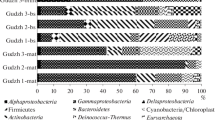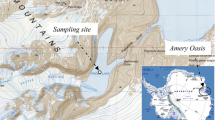Abstract
Poyang Lake is the largest fresh water lake in China. In this study, the objective was to examine the diversity of bacterial community in this environment. The phylogenetic composition of bacterioplankton communities from two sites and two dates (northern and southern sub-basins in October 2006 and in May 2007, respectively) in the water column of Poyang Lake were investigated by partially sequencing cloned 16SrRNA genes. Moreover, restriction fragment length polymorphism (RFLP) was applied in the 16SrRNA gene clones. In total, four clone libraries were constructed and 347 clones were screened by RFLP, yielding 153 operational taxonomic units, which mainly belonged to the proteobacteria, Actinobacteria, Bacteroidetes, Cyanobacteria, Verrucomicrobia and Planctomycetes. Our results showed that Beta-proteobacteria was the most significant lineage, with dominant numbers of operational taxonomic units in the northern October 2006, southern October 2006 and May 2007 libraries. The highest bacterial diversity occurred in the library from the southern sub-basin in May 2007 and the lowest in the library from the northern sub-basin in May 2007. Horizontal and temporal differences associated with the concentration of total phosphorus, water temperature and pH suggested that the trophic state and the physicochemical properties of lake play key roles in sustaining bacterial community composition structure.







Similar content being viewed by others
References
Allgaier M, Grossart HP (2006) Diversity and seasonal dynamics of Actinobacteria populations in four lakes in north eastern Germany. Appl Environ Microbiol 72:3489–3497
Battaglia-Brunet F, Itard Y, Garrido F et al (2006) Simple biogeochemical process removing arsenic from a mine drainage water. Geomicrobiol J 23:1–11
Chao A (1984) Nonparametric estimation of the number of classes in a population. Scand J Stat 11:265–270
Chen XY, Li S (2006) Succession and characteristics analysis on eutrophication of typical lakes along the middle and lower reaches of Yangtze River Basin. Chin Sci Bull 51:848–855
Cottrell MT, Waidner LA, Yu L et al (2005) Bacterial diversity of metagenomic and PCR libraries from the Delaware River. Environ Microbiol 7:1883–1895
Crump BC, Adams HE, Hobbie JE et al (2007) Biogeography of bacterioplankton in lakes and streams of an arctic tundra catchment. Ecology 88:1365–1378
Cupples AM, Sims GK (2007) Identification of in situ 2, 4-dichlorophenoxyactic acid-degrading soil microorganisms using DNA-stable isotope probing. Soil Biol Biochem 39:232–238
De Wever A, Muylaert K, Van der Gucht K et al (2005) Bacterial community composition in Lake Tanganyika: vertical and horizontal heterogeneity. Appl Environ Microbiol 71:5029–5037
Dean WE, Gorham E (1998) Magnitude and significance of carbon burial in lakes, reservoirs and peatlands. Geology 26:535–538
DeSantis TZ, Brodie EL, Moberg JP et al (2007) High-density universal 16S rRNA microarray analysis reveals broader diversity than typical clone library when sampling the environment. Micro Ecol 53:371–383
Fang JY, Wang ZH, Zhao SQ et al (2006) Biodiversity changes in the lakes of the Central Yangtze. Front Ecol Environ 4:369–377
Guo H, Hu Q, Jiang T (2008) Annual and seasonal streamflow responses to climate and land-cover changes in the Poyang Lake basin, China. J Hydrol 355:106–122
Hall RQ, Meyer JL (1998) The trophic significance of bacteria in a detritus-based stream food web. Ecology 79:1995–2012
Humbert JF, Dorigo U, Cecchi P et al (2009) Comparison of the structure and composition of bacterial communities from temperate and tropical freshwater ecosystem. Environ Microbiol 11:2339–2350
Jin X, Tu Q (1990) The standard methods for observation and analysis in lake eutrophication. Chinese Environmental Science Press, Beijing
Lindström ES (2000) Bacterioplankton community composition in five lakes differing in trophic status and humic content. Microb Ecol 40:104–113
Lindström ES, Leskinen E (2002) Do neighbouring lakes share common taxa in bacterioplankton comparison of 16S rRNA fingerprints and sequences from three geographic regions. Microb Ecol 44:1–9
Lindström ES, Forslund M, Algesten G et al (2006) External control of bacterial community structure in lakes. Limnol Oceanogr 51:339–342
Massana R, Murray AE, Preston CM et al (1997) Vertical distribution and phylogenetic characterization of marine planktonic Archaea in the Santa Barbara Channel. Appl Environ Microbiol 63:50–56
Meth′e BA, Hiorns WD, Zehr JP (1998) Contrasts between marine and freshwater bacterial community composition: analysis of communities in lake George and six other Adirondack lakes. Limnol Oceanogr 43:368–374
Mueller-Spitz SR, Goetz GW, McLellan SL (2009) Temporal and spatial variability in nearshore bacterioplankton communities of Lake Michigan. FEMS Microbiol Ecol 67:511–522
Piccini C, Conde D, Alonso C et al (2006) Blooms of single bacterial species in a coastal lagoon of the southwestern Atlantic Ocean. Appl Environ Microbiol 72:6560–6568
Sambrook J, Fritsch EF, Maniatis T (1989) Molecular cloning: a laboratory manual. Cold Spring Harbor Laboratory Press, Cold Spring Harbor, NY
Sekiguchi H, Watanabe M, Nakahara T et al (2002) Succession of bacterial community structure along the Changjiang River determined by denaturing gradient gel electrophoresis and clone library analysis. Appl Environ Microbiol 68:5142–5150
Shaw AK, Halpern AL, Beeso K et al (2008) It’s all relative: ranking the diversity of aquatic bacterial communities. Environ Microbiol 10:2200–2210
Tamura K, Dudley J, Nei M et al (2007) Mega4: molecular evolutionary genetics analysis (MEGA) software version 4.0. Mol Bio Evol 24:1596–1599
The National Environmental Protection Agency of China (NEPAC) (1991) Water quality-technical regulation on the design of sampling programmes. Environmental Science Press, Beijing
Thompson JD, Gibson TJ, Plewniak F et al (1997) The CLUSTAL_X. windows interface: flexible strategies for multiple sequence alignment aided by quality analysis tools. Nucleic Acids Res 25:4876–4882
Tian C, Tan J, Wu X et al (2009) Spatiotemporal transition of bacterioplankton diversity in a large shallow hypertrophic freshwater lake as determined by denaturing gradient gel electrophoresis. J Plankton Res 31:885–897
Van der Gucht K, Vandekerckhove T, Vloemans N et al (2005) Characterization of bacterial communities in four freshwater lakes differing in nutrient load and food web structure. FEMS Microbiol Ecol 53:205–220
Wagner AM, Cloete ET (2002) 16S rRNA sequence analysis of bacteria present in foaming activated sludge. Syst Appl Microbiol 25:434–439
Wu QL, Hahn MW (2006) Structure and dynamics of polynucleobacter communities in a temperate and a subtropical lake revealed at three phylogenetic levels. FEMS Microb Ecol 57:67–79
Wu QL, Zwart G, Wu J et al (2007a) Submersed macrophytes play a key role in structuring bacterioplankton community composition in the large shallow, subtropical Taihu Lake, China. Environ Microbiol 9:2765–2774
Wu X, Xi W, Ye W et al (2007b) Bacterial community composition of a shallow hypertrophic freshwater lake in China, revealed by 16S rRNA gene sequences. FEMS Microbiol Ecol 61:85–96
Yannarell AC, Triplett EW (2005) Geographic and environmental sources of variation in lake bacterial community composition. Appl Environ Microbiol 71:227–239
Zeng J, Yang L, Du HW et al (2009) Bacterioplankton community structure in a eutrophic lake in relation to water chemistry. World J Microbiol Biotechnol 25:763–772
Zhu HH, Zhang B (1997) Poyang lake. Press of University of Science & Technology of China, Hefei
Zwart G, Crump BC, Kamst-van Agterveld MP et al (2002) Typical freshwater bacteria: an analysis of available 16S rRNA gene sequences from plankton of lakes and rivers. Aquat Microb Ecol 28:141–155
Acknowledgments
This project was supported by the National Key Technologies R & D Program of China (No. 2007BAC23B01), National Natural Science Foundation of China (31060082), Jiangxi Natural Science Foundation of China (2007GZN1927). We appreciated the expertise of EX Li for the construction of phylogenetic tree. We are grateful to the staff of Poyang Lake Natural Reserve Protection Station for help with sample collection. We especially thank Prof. Laura G. Leff for her careful review and insightful comments on an earlier version of the manuscript.
Author information
Authors and Affiliations
Corresponding author
Rights and permissions
About this article
Cite this article
Wu, L., Ge, G., Zhu, G. et al. Diversity and composition of the bacterial community of Poyang Lake (China) as determined by 16S rRNA gene sequence analysis. World J Microbiol Biotechnol 28, 233–244 (2012). https://doi.org/10.1007/s11274-011-0812-5
Received:
Accepted:
Published:
Issue Date:
DOI: https://doi.org/10.1007/s11274-011-0812-5




